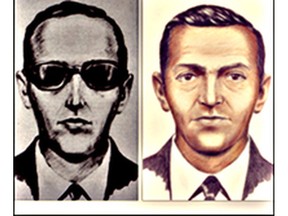
Fifty-three years ago, the legend of D.B. Cooper was born. An unidentified man hijacked a Boeing 727 that was on its way from Seattle, Washington, to Portland, Orgeon on Nov. 24, 1971. His demands were that upon landing in Seattle, he wanted four parachutes and $200,000 cash. The man said he had a bomb and revealed to a flight attendant what appeared to be a dynamite-type of device in a briefcase.
The plane landed and passengers were released in Seattle. The hijacker then instructed the flight crew to head towards Mexico City, with a plan to refuel in Reno, Nevada. But 30 minutes after takeoff, the hijacker used the back door of the plane to parachute into a night sky over Washington state. He escaped with the ransom — 10,000 $20 bills.
The hijacker was never identified. He called himself Dan Cooper, but many media reports out of the United States mistakenly referred to him as D.B. Cooper and that name stuck.
The following article is the first story about D.B. Cooper that appeared in the Calgary Herald, on Nov. 26, 1971.

There was something about the daringness of Cooper’s crime that captured the imagination of many. It was the first time such a caper had occurred, with a hijacker using a parachute to flee the scene of the crime. While the money demanded now seems a tad modest, at the time it was the largest amount of cash a hijacker had ever successfully received in the United States.
The fact Cooper allowed all the passengers to leave the plane safely also bode well for his legend. And, the fact no one could figure out who he was or where he went added to the mystery that even today is baffling.
The following Calgary Herald story from 1972 notes that police tried to remind people D.B.
Cooper was a dangerous criminal. However, his legend grew thanks to a song and T-shirts, which sold for $1.50 each.

Some law enforcement folks speculated that Cooper must have died during the parachute jump. A bit of the ransom money was found along a river bank in Washington in 1980. But no body or remains were ever discovered.
The mystery of D.B. Cooper endured, even attracting tourists to the jump site each November.

The case puzzled the FBI for decades. In 2007, a new agent took over the case in hopes he could use modern technology to find answers.

Plenty of suspects were investigated over the years and in 2011, an Oklahoma woman claimed D.B. Cooper was her uncle. The claims weren’t proven, however. This article was published 40 years after the hijacking, as the FBI looked at fresh leads.

The FBI kept an open file on the case for 45 years. During that time, countless theories about the identity of the hijacker were floated and investigated, but no definite conclusion was ever reached.
One interesting arm of the investigation examined whether D.B. Cooper spent some time in Canada after the hijacking and even attended a Grey Cup game in Vancouver that same month.


On July 8, 2016, the case was officially closed. There were more pressing matters to take care of and using FBI resources to continue looking into the hijacking was not a priority. The case file was 66 volumes in size.
The year after Cooper’s crime, 1972, saw 15 similar hijacking attempts — involving a demand for a parachute —occur. All were unsuccessful. The following year saw luggage searches become a common practice at airports and hijacking attempts largely decreased.
****